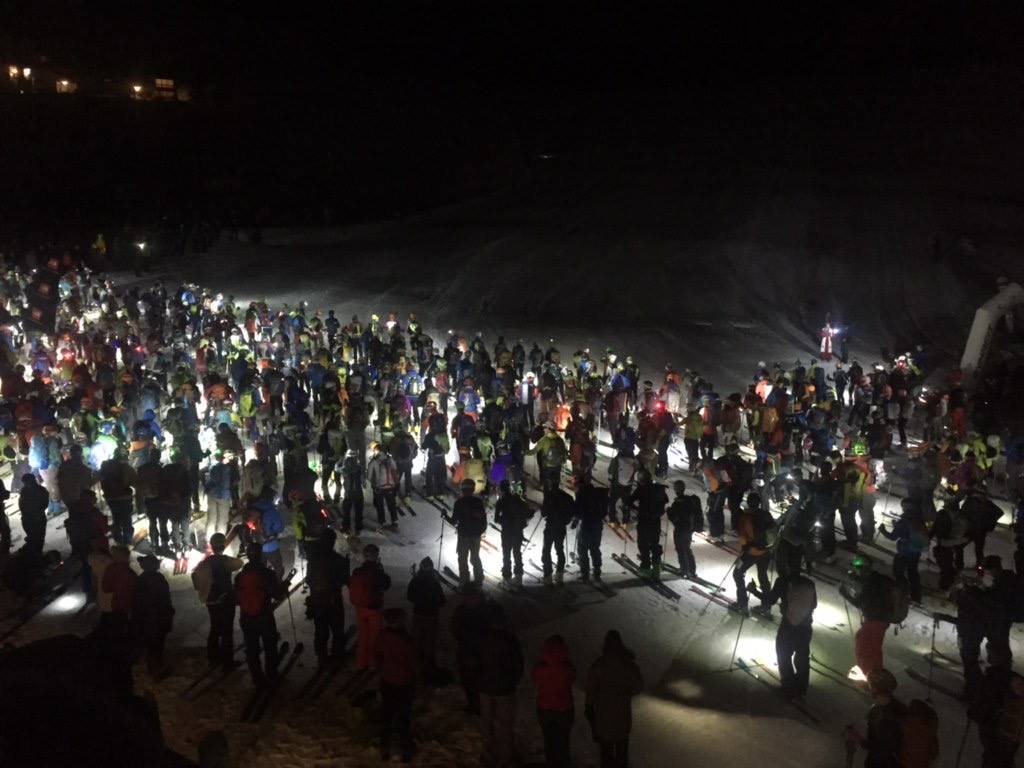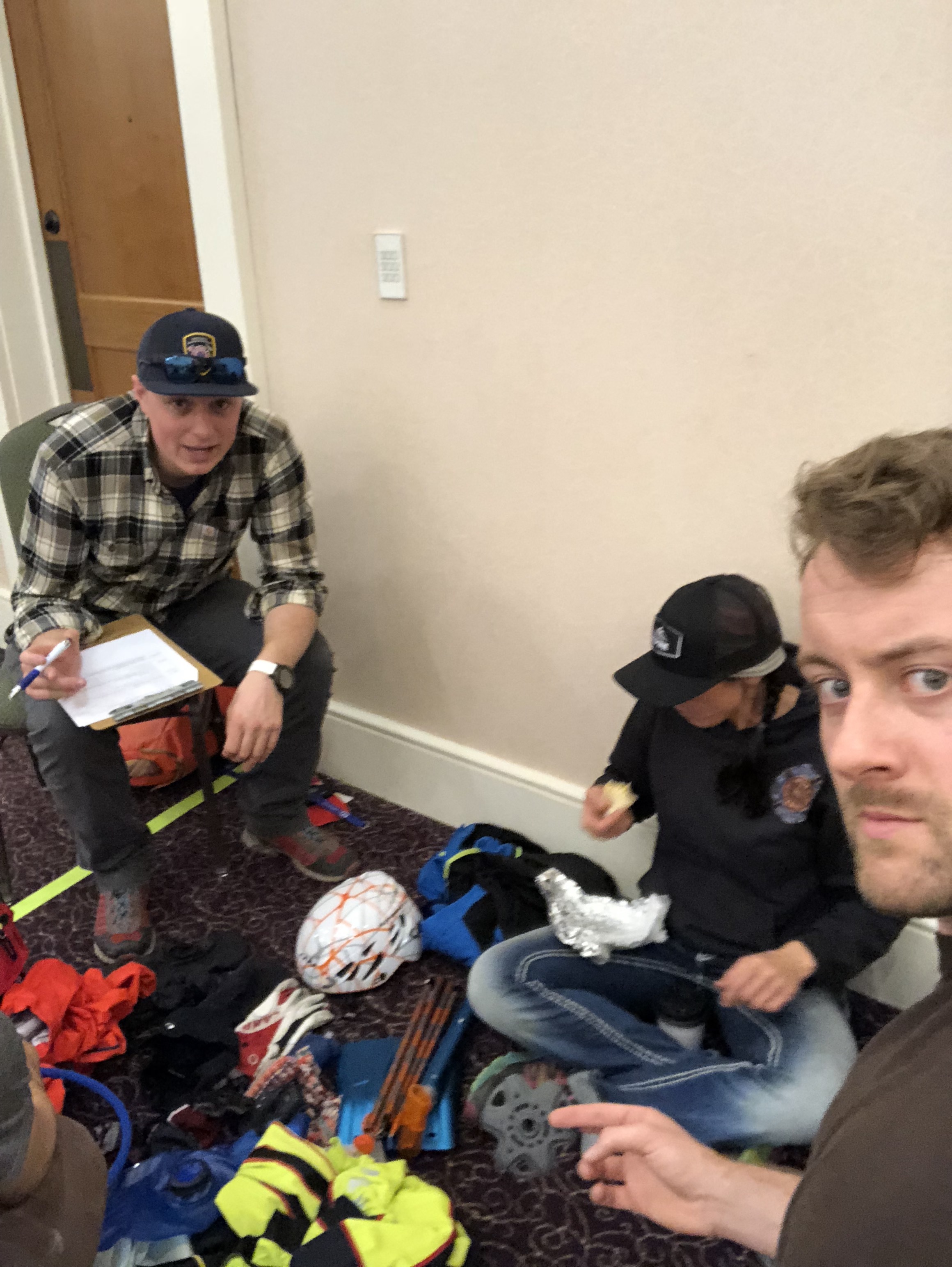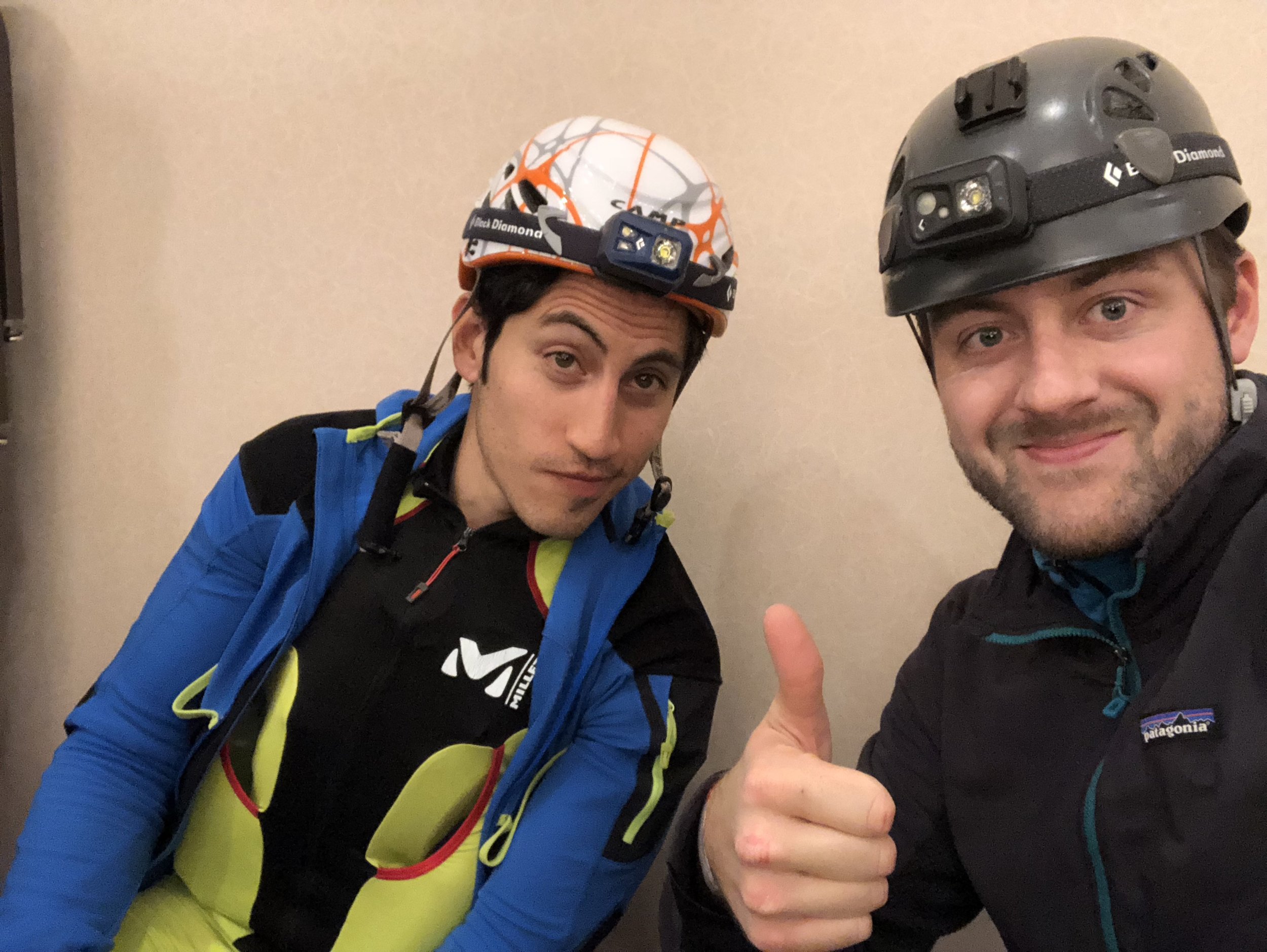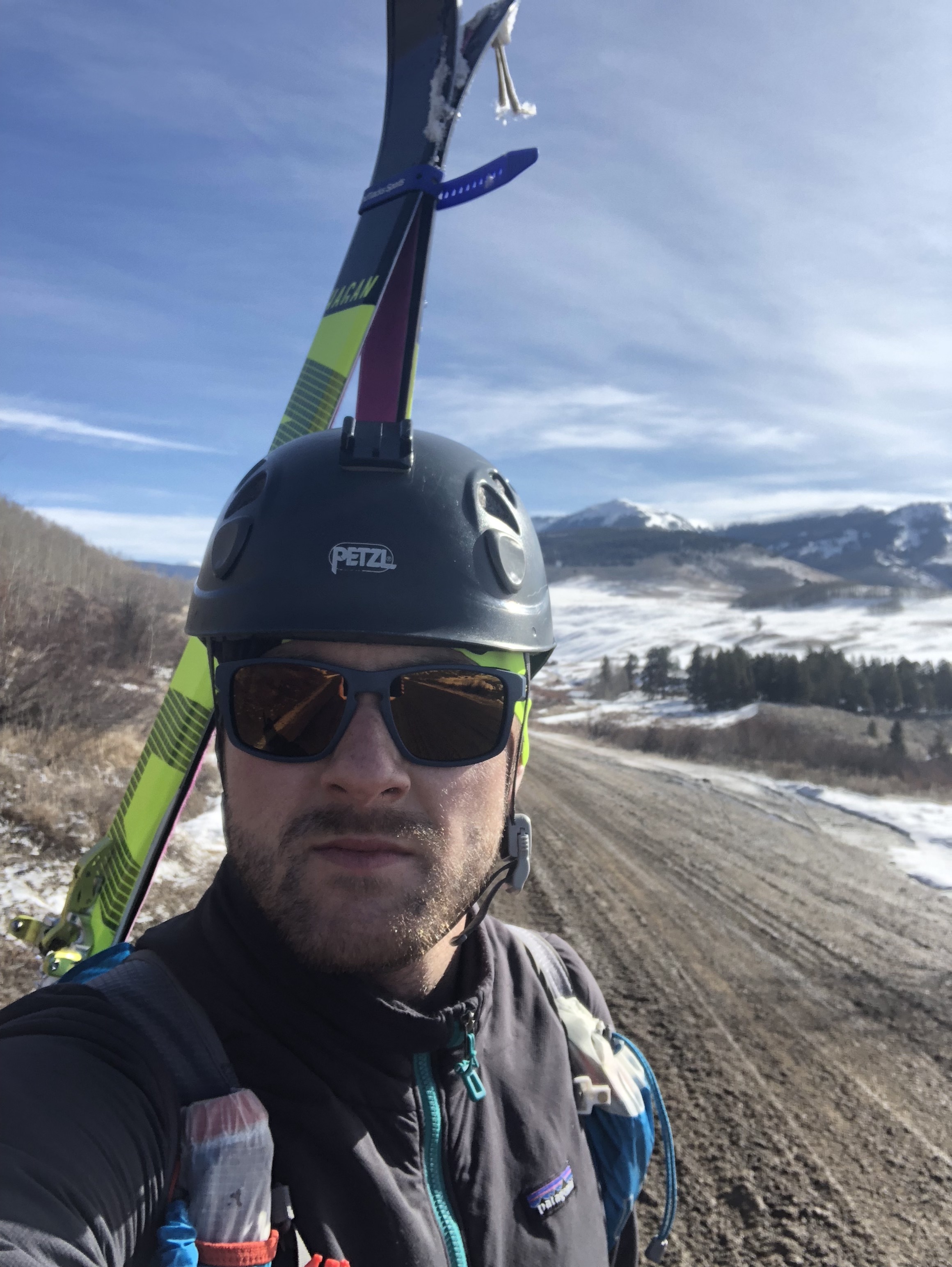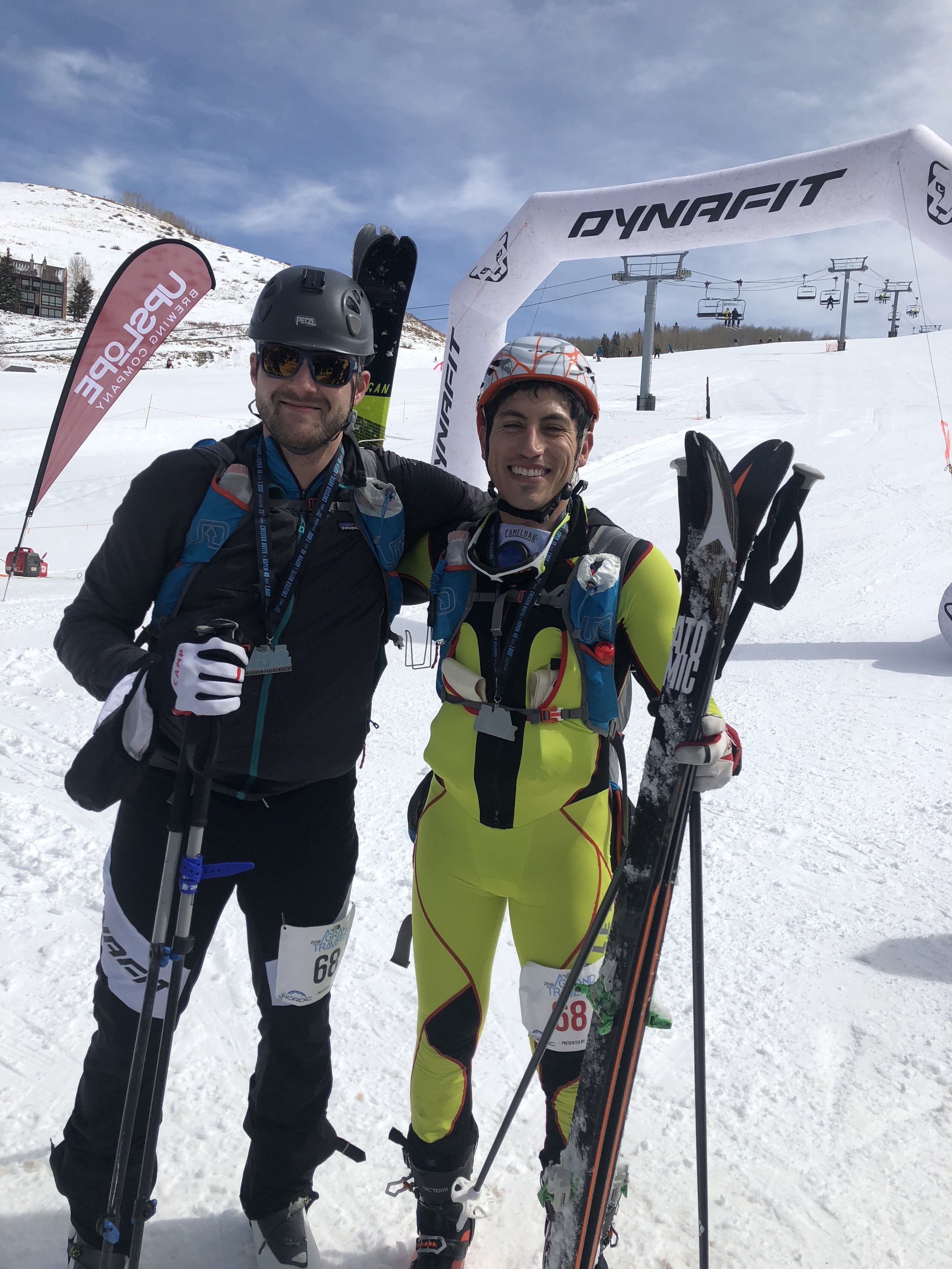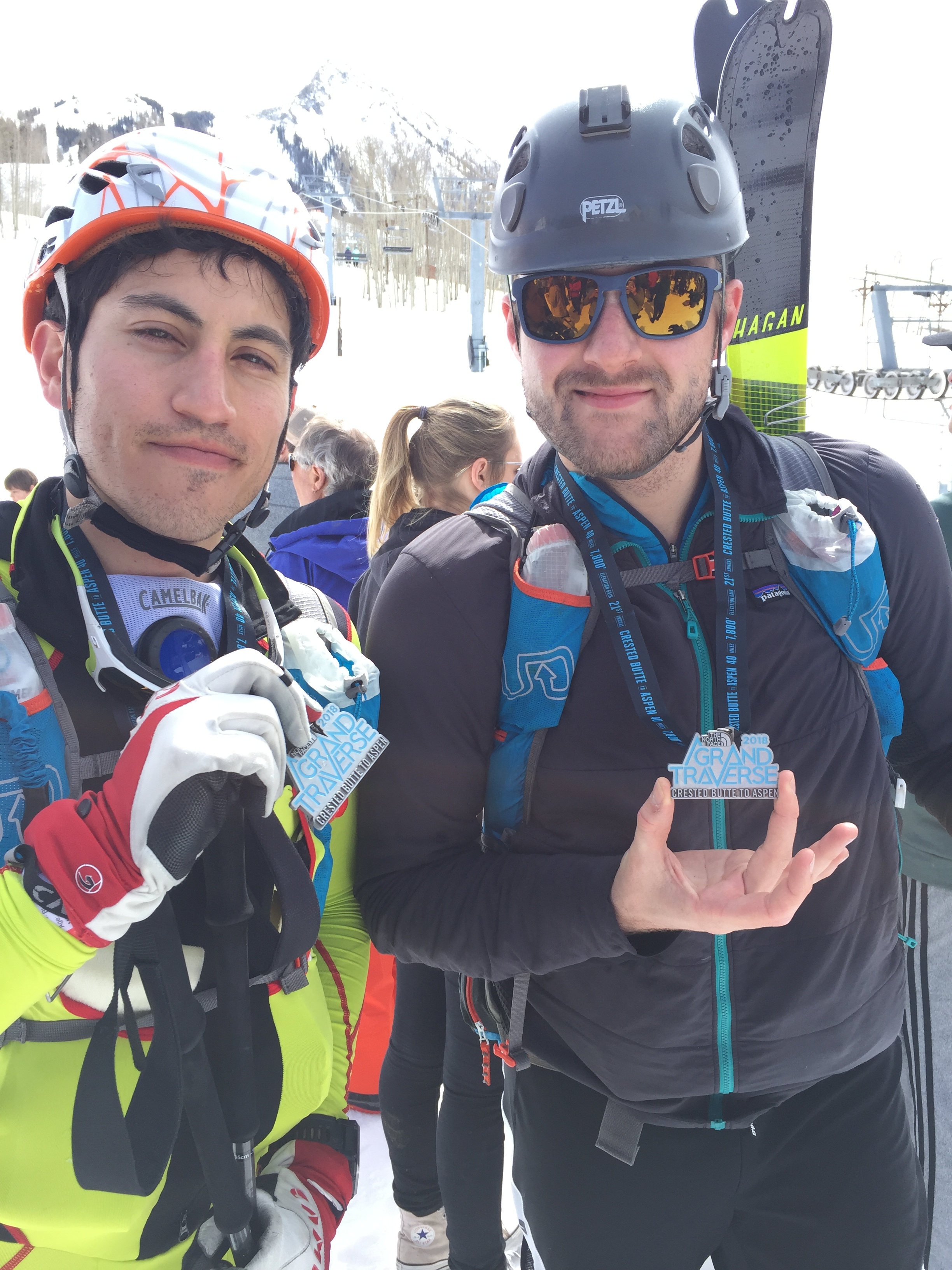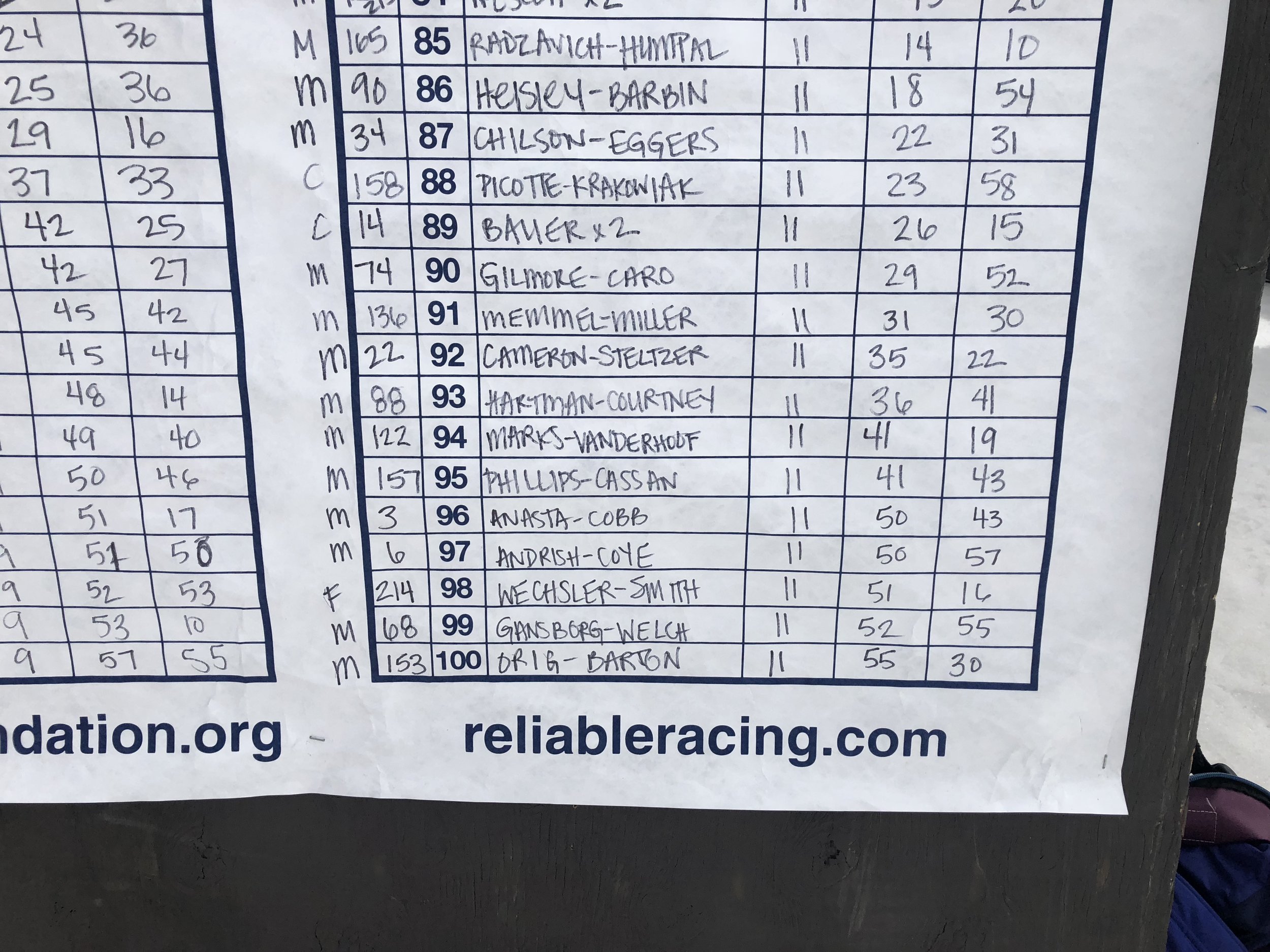Skiing the Grand Traverse
It was 1:15 a.m. on Saturday, March 24th. No wind, no precipitation. That night's crescent moon had just set behind the ridge-line into the adjacent Maroon Bells Wilderness and all I could see were my skis, those of the person in front of me, and a string of headlamps shuffling ahead, by twos, into the darkness.
I felt an unusual sense of calm and inevitability about this whole situation. After months of training and days of logistics, my partner Blake and I were finally underway at our first Grand Traverse.
Pre-race packing
By 5 p.m. the prior evening we had meticulously gathered the list of required items (e.g. 3' of bailing wire, 2mm cord, a triangular bandage, safety pins, etc.) and packed our gear into matching 28 liter packs (coincidence, go team). Our overall philosophy was to go lightweight except for plenty of extra skins (we had 7 total pairs between us) and insulation warm enough to last a night out if need be. The course briefing earlier in the day called for ~10 miles of hiking so we contemplated bringing trail runners but both agreed our touring boots were comfortable enough. Except for last-minute layering decisions, there was nothing left to do but lie down for a nap (sharing the queen bed of our AirBnB for pre-race team bonding).
All morning and afternoon a storm had been depositing several feet of snow on avalanche prone terrain near Star Pass (the crux and highpoint of the ~36 miles course from Crested Butte to Aspen). Because of the rapidly forming storm and wind slabs along with the whiteout conditions that prevented volunteers from controlling or assessing that terrain, the snow safety teams called for a Grand Reverse--essentially turning an epic A-to-B race into an epic out-and-back race with similar vertical and distance. Honestly, despite this being plan B and certainly less dramatic geographically, the idea of physically reaching a turnaround point and then backtracking felt psychologically less daunting.
The weather forecast was very cold up at 12k feet but surprisingly warm at the resort (21 deg). So we dressed for the warmth, ditched some heavier layers, and drove to Mount Crested Butte for the start.
Food + Water
To eat, I brought ~12 GUs or Honey Stinger Chews (some caffeinated, some not), buffalo jerky for pure protein, and two nuttier Taos Mountain Energy bars. Despite my best effort, I only ate half the food. I should probably get a bit more scientific about this...
As for water, we were required to bring 3L and I basically finished exactly that much--more than I usually do at sea level because I consciously tried to sip water every time I felt a bit of altitude. I used some Nuun hydration tablets to stave off any cramping in the later segments.
The start
By the time we were actually walking out the door to the start, fully packed, with no more decisions to make, I was ecstatic! We didn't overthink our place in line, just found an open spot, clicked in, listened to The Blessing of the Freeheelers (a quirky 11:58pm skimo prayer) and waited for the gun.
First 10 miles
The race starts with a two mile, moderate skin up an easy run to the back of the CB resort. The energy of our 400 fellow racers and the disarmingly nice weather had us immediately going faster than race pace, even though we were actively talking about not doing that. We skinned at a pace of 30min/1k vertical feet versus our goal of 40min/1k. Moreover, we transitioned a bit early leaving ourselves a quarter mile skating and further jacking up the heart rate. Then for the ski down, we went pretty hard thinking this was one of our only chances to ski the whole race. While this wasn't ideal we did manage to pass some folks which would pay off on the upcoming miles of single-track that were a bit of a bottleneck.
After that brief up-and-over starting segment, we had 14 miles of straightforward skinning with a very gradual incline from 9000 to 11,900 feet.
The field was pretty bunched up here causing some interruptions in our stride. But the skin-track and snow were very efficient--not too wet or unconsolidated. We targeted a 4 mph pace and kept debating whether to pass people if only to get some more personal space. I didn't feel rushed or mind going slow, but whether we were going at 2.5mph or 4mph, I wanted each step to count. All in all, we probably got passed more than we passed others and this was more of a mental game than something that actually influenced our time. If anything, all that traffic and excitement in the first 10 miles distracted me from the totality of the race.
The "crux"
Right around mile 13 and 10,500 feet of elevation, the field thinned out, the skinning became less mindless, and getting to the next checkpoint seemed like it would take forever. It was 4am and while my legs were warm, the cold was seeping into my fingers, face and shoulders. At this point, both of us were fiddling with gear, water and food, all without trying to stop. So we took our first (and one of few) full stop breaks for a few minutes to regroup. We also committed to slowing down for the upcoming miles to be conservative. I'm glad we did this because as soon as we got above 11,000 feet, I started to feel the altitude and the familiar temptation to close one's eyes and take a nap. But I was able to just be mindful of this and reassure myself that I had done plenty of training and enough acclimatizing to power through, one step at a time.
We reached the first major checkpoint around 530a, 1 hour before the strictly enforced cutoff. I was wearing my warmest gloves but my fingers were still cold. What looked like a welcoming bonfire from far away turned out to be a measly LED lantern. Without being able to warm our hands, Blake and I graciously accepted about 750 mL of melted snow from the hardy volunteer crew and kept moving. I had already finished 2L at this point--way more than I expected and would normally consume at sea level.
I couldn't help but overhear teams either discussing dropping out or others talking about how good they felt and planning to go faster. Both extremes intimidated me and I blocked everyone out. One unfortunate racer was trying to thaw his frozen skins with his bare hands and screaming with frustration. Another reason to keep moving...
We had to skin up 500 feet and another mile or so toward Star Pass to a well-earned ski down. This last section was a bit of a slog and a stark change of incline from the gradual striding we had been doing, but the distant hooting and hollering of teams ripping skins was promising. We didn't feel amazing, but it started to seemed obvious that we were going to finish.
Skiing down
Somehow the terrain between miles 17-23 was at the exact angle at which my 200 lb frame on 161cm race skis could ski but only by propelling myself with poles. It was almost comically frustrating not being able to just glide--but the race skis were definitely faster than my 183cm Dhaulagiris on the way up. At least my legs got a break and it was more of a 1 hour upper-body workout.
Coincidentally, by the time we pushed ourselves back to Pearl Pass and a crossing of Brush Creek the sun had mostly risen and we took this opportunity to apply sunscreen, whip out sunglasses, eat something and drink up after an hour of skiing. Now I that I could actually see our surroundings, I appreciated how lucky we were to race through such beautiful terrain.
The morning
Starting around mile 24 up until 28.5 we enjoyed a mixture of downhill skinning, low-angle skiing, booting and skating. The constant variations in ground cover took my mind off of the drudgery but made for slow going. We averaged about 2.5mph through this section. The winning strategy was clearly to skate through this relatively groomed section as much as possible. But we weren't familiar enough with the segment nor practiced enough in our technique to make skating anything other than a full on quad-punishing workout in the middle of a 36 mile race.
After passing hundreds of shivering cows and a handful of seasonally occupied country homes, we finally arrived at the second major checkpoint around mile 29. My quads and hip flexors were getting a bit tired of the repetitive effort of skinning on a slick, wind-scoured road, but fortunately I had no major hotspots or fatigue. If anything, the inconsistency of the terrain made it hard to really get our heart rate up to threshold which made this section more of a balancing act and controlled fall than an aerobic challenge.
The hiking
The friendly volunteers at this checkpoint had hot coffee, gatorade, and other goodies. I even got to thank Sierra from the Alpineer for punching out my boot the day before. The checkpoint was positioned at an abrupt snow-to-dirt transition. The next segment was to circumnavigate Mount Crested Butte on a mountain bike trail carrying our skis. Some folks were encouraging us with you're almost done but I blocked that out and kept telling myself you're about to do a really hard hike, at altitude, on tired legs.
Despite this being a "ski" race, I welcomed the switch to hiking as it targeted some different muscles and felt great. The winning strategy was certainly to run this portion...
We hiked pretty vigorously for the next few miles until we realized we were redlining and agreed to keep it gradual until we actually got some clarity about how close we were to the finish. While we prepared for the A-to-B race, we didn't have any GPX file or real certainty of the remaining distance or milestones.
The finish
After a very long hour and a beautiful traverse above the East River Valley with views of town, we encountered some race volunteers who said, "OK, just go up this road a quarter-mile and then you're at the resort".
We couldn't believe it! Our GPS was only at 34 miles so we knew that couldn't be the end. At this point, I was glad I braced myself for a full 40 miles (instead of the eventual 36). Upon hitting snow again at the border of the resort, we could see and hear the crowd at the finish. Just a final stretch of skinning left--basically a traverse under the frontside lifts as downhill skiers and lift passengers cheered us on. Excited for one last descent, we ripped skins and charged top speed toward the white Dynafit inflatable finishing arch. We finished in 11h 52m, better than our goal of barely making the cutoff.
A race volunteer welcomed us with a hug and a medal for finishing. Many of the friends and family gathered for other racers gave us high fives and Blake's girlfriend showed up in no time! What an amazing experience.
Recovery
Other than half a beer and getting pizza in town at The Secret Stash (while wearing spandex), my post-race recovery included some mild stretching and a 3 hour nap. The next day the pads of my feet were sore and my legs were tired, but gladly everything else felt good enough to do a little hike near Mount Princeton on my drive back to Denver. The achiness lingered in my legs for about 5 days--almost the way they would feel after a night of drinking in college.
Reflections on training
When I first learned of this race in December, it instantly became a priority. I was so desperate to do it that I went onto Facebook and basically partnered with a stranger. Being acocuntable to each other on Strava, and my suspicion that he was faster than me was a huge motivator.
My only experience with distance training was for a half marathon so I knew I needed some outside help. A lot of the skimo-specific training advice I found was for shorter distance, more vertical races. With a little googling, I found Alison and Sam of Cascade Endurance--both experienced endurance athletes and organizers of the Loup Loup Randonee Race in Twisp, WA.
Alison did a thorough intake and completely digested my fitness goals. Then she worked with me to craft a ~3 month training plan with hours of aerobic, low-intensity time out touring. By far, training in this fashion and with a coach was the single biggest contributor to my finishing this race. Because I had accumulated so much mileage and had someone with experience looking at my performance, I was confident in my ability to actually finish and could focus on executing the race.
I've officially caught the bug and cannot wait to prepare for my next endurance goal.
